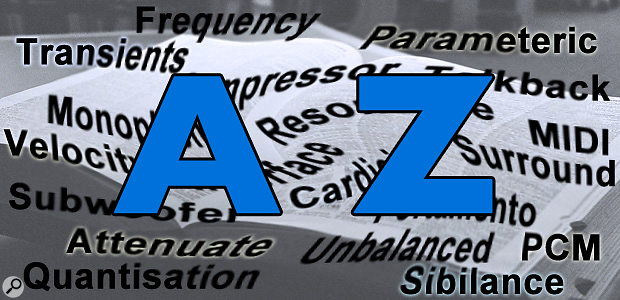You are here
Glossary
A guitar effects device where a bandpass filter is varied in frequency by means of a pedal control.
A subjective term used to describe sound, where the bass and low-mid frequencies have depth and where the high frequencies are smooth-sounding rather than being aggressive or fatiguing. Warm-sounding tube (valve) equipment may also exhibit some of the aspects of compression.
Unit of electrical power named after its founder, James Watt.
A graphic representation of the way in which a sound wave or electrical wave varies with time.
(as in, 2-way, 3-way) - A colloquial way of denoting how many separate frequency bands are reproduced by a loudspeaker. Most are two-way systems with a woofer and tweeter, but some are three way with a woofer, midrange and tweeter.
A signal that has effects added. (cf. Dry)
A random signal with a flat (constant) power spectrum density, ie. equal power within any frequency band of fixed width. White noise sounds very bright (cf. Pink Noise).
A mechanical acoustically-transparent screen placed in front of or completely enveloping a microphone to prevent moving air currents from impacting the diaphragm and generating unwanted noise. In studio use a wind-screen is typically used to prevent plosive blasts from vocals or speech reaching the mic diaphragm, and it's typically a large disc made of a two layers of mesh fabric, a perforated metal disc, or an open-cell foam disc. In location sound gathering applications a wind-shield is typically a large fabric-covered frame which completely envelopes the microphone with a volume of still 'dead air'.
A word is a unit or block of data employed in a computer. A typical word length is 8-bits and normally called a byte.
The precise timing of digital audio samples is critical to the correct operation of interconnected digital audio equipment. The 'metronome' that governs sample timing is called the Word Clock (sometimes conjoined to 'Wordclock', or abbreviated to 'Wclk'). However, word clock does more than merely beat time; it also identifies the start and end of each digital word or sample, and which samples belong to the left or right channels. Digital interfaces such as the AES3 and S/PDIF embody clock signals within the data stream, but it is often necessary to convey a discrete word clock between equipment as a square wave signal running at the sampling rate. Dedicated word clock inputs and outputs on digital equipment generally use BNC connectors.
A word is a unit or block of data employed in a computer, and so the word-length defines the number of bits employed in each word. A word length of 8-bits is normally called a byte. The CD format uses a word-length of 16 bits, but more modern systems typically use a 24-bit wordlength.
A cyclical variation in replay speed which affects the pitch of the recorded material. Wow is a low-speed variation (nominally below 4Hz) which typically occurs once per revolution of the device and may be caused by an off-centre hole on a vinyl record, or a sticking tape on a reel-reel machine. Flutter is a higher speed variation (nomninally above 4Hz) and can often be perceived as a form of intermodulation distortion.
The parameter of tape head alignment related to the rotation angle of the head in a vertical axis which determines how the tape arrives and leaves the head gap. (cf. Azimuth and Zenith)
To save data to a digital storage medium, such as a hard drive.

